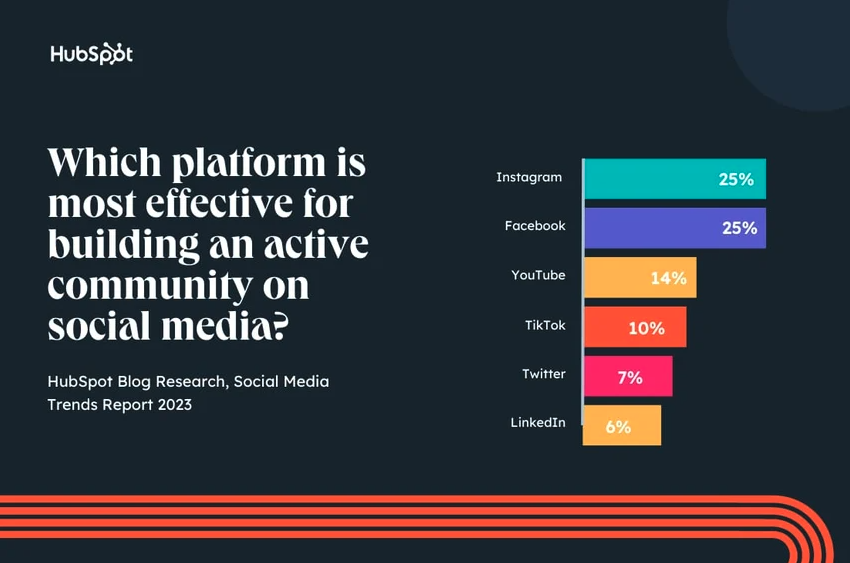Standing Out Amongst the Social Media Noise

Social media burnout: is it real?
The way we use media is changing quicker than ever before. New apps are constantly being developed and an endless amount of scrollable content is always available at our fingertips. Even as marketers, it can feel tireless and overwhelming to feel “in the now” about the state of things.
The recent years of the pandemic have demonstrated how connected we all are to one another, and how important of a tool social media has been to keep us feeling connected to a larger community, even when we’re not physically together. The idea of society facing social media “burnout” is certainly not a new one. A few years prior, you might have felt that burnout just meant being tired of the sheer amount of content out there. Today, this burnout feeling is more than that, it’s also about feeling overwhelmed with never being able to fully unplug. And the constant need for the endless digital tools needed for every aspect of our lives.
Information overload
While the way we consume information has changed drastically over the past few years, it’s often hard to dispel whether or not we’re becoming experts at retaining it. This begs the question as to how much of that we’re actually able to retain? How much information is too much? We’ve learned that at a certain point, our ability to retain and make sense of new information does hit a standstill.
To put things in perspective, prior to a few hundred years ago, most people went days or weeks without encountering news that didn’t involve their own immediate community. A single edition of the New York Times today contains more information than the average 19th-century citizen faced in their lifetime.1 Today, the average person is bombarded with glorified Instagram highlights and global news updates (that are often distressing more than anything). More and more modern knowledge-based industries expect this of their workers too; to research, analyze information, and to be in communication with clients on an ongoing basis.
So if there is this stream of content that people are being fed, how does a brand stand out on such a cluttered feed? We believe it lies in connecting with the right audiences. With buzzing phishing emails, constant newsblasts and an online world of misinformation, we believe that there is an inherent need for authentic content.
Using your USP to stand out
Every brand wants to create their own niche. However, without being specific about your brand’s “unique selling point” or USP, it can be hard to clarify how this is possible within your target market. Many competitors can exist in a single market because they all bring unique offerings. Even if your brand has had some skin in the game, your clients relationships to the brand may change as their interests shift. Finding ways to keep connected and engaged with your audience is how we believe that your content will stand out.
Many famous brands like MEC, Meta, or even the recently reacquainted Barbie-brand “Mattel”, have redefined themselves time and time again to better speak to their ideal client.
Nostalgic rebranding
If you live in Canada you’ve probably heard of the infamous outdoor lifestyle brand Mountain Equipment Coop (MEC). In the past few years, the brand has taken a few drastic shifts in redirection, as the company struggled financially for several years prior to being purchased by Kingswood Capital in 2020.2 A year after its new ownership, the brand leaned into the nostalgia of its original brand created in the 1970’s. The shift away from its ambiguous square logo, along with renaming itself to “Mountain Equipment Company” demonstrates the clarity in the outdoor audience that their brand is trying to reach and the nostalgia connection with the off-the-grid outdoors lifestyle that MEC was originally created for.

Other companies like Mattel have leaned into this nostalgic rebranding to better connect with their audiences. For Mattel, their infamous “Barbie” has been a long time icon of the toy brand. Although iconic, the brand itself has been criticized for its promotion of unrealistic beauty standards for children. The #MeToo era also further demonstrated the shift in cultural beauty standards; and the long legged, pin-waste Barbie wasn’t exactly portraying the idea that all bodies are beautiful.
Whether or not you were a Barbie fan yourself, you’ve likely seen the pink-themed everything gorging counters and people’s closets. Some may argue that the recently aired Barbie movie was really just a two-hour long Mattel commercial, preaching for sympathy with the misdirection of the brand. The brand has powerfully leaned into this nostalgia, speaking to that millennial generation that used to play with Barbies as kids. The movie is just a reminder for them of the good that came from Barbies, and perhaps to have them reconsider buying Barbies for future daughters, nieces, and so on..

For both these companies, they’ve managed to remain relevant because they’ve found innovative ways to speak to their core audience and clarify their brand intentions. While nostalgia rebranding has been a trend in an oversaturated market, there are other ways to stand out other than to connect with things that we’re already familiar with.
New apps, content fatigue
Brands are finding it harder than ever to connect with their audiences simply because of how many platforms are out there. It can also be hard to predict which platforms will actually stick around, as we’ve seen that different generations find new platforms that they connect to. There’s also been an overall shift away from major Meta platforms like Facebook or Instagram, as competing apps like Tiktok or BeReal have changed the way we choose to connect with others online. People now want cheap laughs, more accessible “authentic” content, and want to feel more connected to their favourite entertainers and brands.
Building community
With different social platforms becoming more exclusive, it’s essential for brands to lean into finding ways to better connect with their own audiences. We believe the most successful brands use their content to build on community, by valuing presence and not just passive scrolling. From a 2023 Hubspot research, Facebook and Instagram are still the most actively used social media platforms worldwide.3 This is likely because of its demand for engagement, and is an accessible platform to connect groups, students, and organizations with resources and information in real time.


Find ways to engage, not to sell
Another important strategy for standing out in your market is looking for new ways to engage your audience, by considering what kind of emotional tone you want to set for it. People will come back to your page if they feel like they’re continually getting something valuable from it. With how many advertisements appear on websites or any online content, we’re constantly being bombarded with brands trying to sell us things.
Brands with a strong message, like the athletic wear company, Gymshark, or the outdoors brand, MEC, aim to motivate us with their content. They strategically use their page to make content that excites and motivates people to get outdoors. They also share featured posts and ideas that are useful tidbits for adventure junkies like sharing camping tips, fire-side meal ideas, exclusive giveaways. They also spotlight certain follower posts and photos to make them feel engaged and seen from the outdoors community.
This is a reminder that even in an oversaturated market, there is always room to choose to be subjective and stand out to those right customers. Especially if you’re just starting out, or trying to rebrand, there can be a tendency to try to broaden your reach as much as possible. When really, narrowing your target audience can get you more qualified leads which turn into reliable customers that remain loyal to your brand.
Conclusion
Burnout is a real phenomenon we’ve all faced with all the screen time we’ve become so accustomed to. Though it may seem easier than ever to grow your business from nothing, it’s also intimidating feeling like a needle in a haystack for customers to actually find you. By strategically using your social media to really hone in on your business’s unique selling points, as well as actively engaging audiences by clarifying the tone of your content, there are ways to still stand out to those that value your service or product.
In a sea of neverending scrollable content, it’s important to remember that the right people just want to feel seen or heard by your messaging. By thinking of social media as a means to share stories and provide your clients with relatable content that they’ll find useful, you’ll give them a reason to rely on your insight, or make others in the industry feel connected to the larger community your brand is a part of.
Read some of our other blogs for information about our services:
Sources
- Pentina, Iryna. Tarafdar, Monideepa. (June, 2014). From “information” to “knowing”: Exploring the role of social media in contemporary news consumption. https://www.sciencedirect.com/science/article/abs/pii/S0747563214001137
- Javaid, Maham. Kaur, Anumita. (July, 2023) Download. Scroll. Post. Repeat. New social media apps are exhausting us. Retrieved August 28th, 2023 from: https://www.washingtonpost.com/technology/2023/07/07/social-media-platforms-threads-twitter-fatigue/
- Quin, Anicka. (2021). Mec’s New Logo is a Sweet Hit of Nostalgia. Retrieved August 29th, 2023 from: https://www.vanmag.com/style/stores/mecs-new-logo-is-a-sweet-hit-of-nostalgia/
- Santiago, Erica. (August, 2023). 22 Facebook Stats to know in 2023. Retrieved August 30th from: https://blog.hubspot.com/marketing/facebook-video-stats-infographic?hubs_content=blog.hubspot.com%252Fmarketing%252Ffamous-rebrands&hubs_content-cta=null&hubs_post-cta=blognavcard-marketing
- Chapman, Josh. (December, 2022). Information overload: How much information we consumed in 2022. Retrieved August 25th from: https://heyday.xyz/blog/information-overload/#:~:text=According%20to%20our%20recent%20study,words%2C%20and%20226%20messages%20daily.